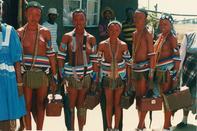Byale Initiation
On the day the male Pedi bogwera initiation session ended, the byale, the girls' initiation began. Only girls who had undergone a puberty ceremony were eligible to be initiated.

Assisted by the older women, the byale was directed by the principal wife of the chief. Although the chief had the overall responsibility and authority for the byale, he was not directly involved in it in any way. The girls were summoned to the chief's kgoro by the blowing of the war-horn 'phalafala'.
They were led to a secluded place in the veld where all their hair was cut off. Their mothers gave them a special leather apron 'kgakgo' which they wore in front, combined with a back-apron 'nthepana'. They also wore a short smocked shirt 'gentswana or nyebelese'. The smocked style was originally introduced by missionaries but has become an article of clothing which denotes a traditionalist orientation.
Their bodies were smeared with a mixture of red ochre and fat, after which they had to collect firewood and return to the chief's kgoro for the night. Before sunrise they were lined up in rank and treated with protective medicines. This was followed by individual lashings in rank order, prior to being marched off into the veld. At a secluded spot they underwent a frightening circumcision charade which emulates that undergone by boys. The girls would then be taken to a lodge where they were secluded for a month.
During this time they received formal instruction on the work and duties of women. They were taught to respect all men, particularly the chief, given instruction in sexual matters and subjected to endurance tests. Singing and dancing played an important part in the byale and a special drum 'moropa', which was normally kept by the chief, was used for this purpose.
After Seclusion
After the seclusion, the girls bathed and participated in rituals and were then allowed to return home. In traditional times their legs were tied together at the knees and the girls' bodies were covered from the neck to the ankles in grass mats. They had to remain in this stage of transition for nine months, or until the harvest had been reaped. In recent times this period has been considerably shortened, to accommodate the demands of formal schooling.
During this time the initiates assisted their mothers by day in their chores and retired at night to a special enclosure 'thupantlo' which was built behind the homesteads of every kgoro. Here their tuition continued in the form of special initiation songs and monotonous repetition of formulae.
At the conclusion of the byale, the initiates were secluded in the veld for about 10 days while dikomana (initiation secrets) were revealed to them. The initiates were incorporated into a regiment, whose leader was the senior initiate. Again their hair was shorn and they bathed, after which they were smeared with fat and ochre. They proceeded to the royal kgoro, where they remained for two days. During this time the initiate was known as a sealoga.
Once this period was over, they bathed in the river for the last time. Their parents gave them new clothes, which consisted of the stringed apron of the unmarried girl in the front and, reaching to the ankles, the back apron of married women (nthepa). They wore a longer version of the smocked shirt (hempe or nyebelese). They changed their hairstyle to the tlopo, where the hair was formed into a flat bun on top of the head with the back and side hair shorn off.
This was once the everyday headdress of marriageable and married women, but its use is now restricted to initiation itself. The initiated girl was now known as mothepa, a stage leading up to full initiation (kgarebe). After this the girl was eligible to marry.
Pedi girls passed through stages of development and incorporation into society: lesea (baby); mosetsana (girl); lethumasa (uninitiated girl); kgarebe (mature maiden); sealoga (member of a brief period of transition); mothepa (initiated maiden); kgarebe (maiden with recognition of her status of maturity). However, a female attained the status of being a woman (mosadi) only once she was married and had borne a child.